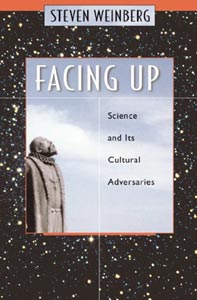by Steven Weinberg, Harvard University Press, ISBN 067400647X, £17.95 (€ 28).

These 23 essays written by Steven Weinberg from 1985 to 1999 make a nice collection around the theme of reductionism. Each is preceded by a page or so describing the context, which is often a valuable addition to the main texts of the essays. Professor Weinberg’s introduction to the set led me to believe that the book would be about facing up to the reality of a neutral universe: Tycho Brahe’s statue looking up to the sky is on the cover. The secondary title is more apt: the majority of the essays are in defence of the scientific approach to understanding our surroundings. Flaws in other approaches, especially constructionist, are pointed out.
Weinberg makes a strong case for reductionism. Phenomena can be explained in terms of others, but these explanations come in a hierarchy, which clearly points back to a theory of everything, as yet to be discovered. Physics is closest to this origin and physicists are closing in.
Not being a physicist myself, I found that many of the essays are brilliant formulations of our understanding of physics, better than anything I have read before. Apart from two more or less political statements, which I felt were out of place, the collection is very homogeneous. However, this is also its weak side: points are necessarily repeated and I will now certainly remember that the Standard Model has 18 parameters that we cannot yet calculate. From 1985 to 1999 many things happened to high-energy physics, such as the cancellation of the Superconducting Super Collider. Unless one knows the dates of these events, it is somewhat confusing to the non-physicist to follow the arguments as there is neither a synoptic nor a statement of the current state of affairs.
One thing I am not so sure of is the “emergence” argument. According to Weinberg, apart from historical accidents (initial conditions), what we observe can be understood exclusively in terms of the hierarchy of explanations, with physics at the root. However, computer simulations (for example of neuronal systems) seem to indicate that more than one underlying “physics” can indistinguishably lead to the same behaviour, by construction. Does that not mean that the mathematics governing this behaviour is independent of those physics? Then there may be independent sciences after all.
My favourite essays are the one in which Weinberg takes the humorous view that non-physicists are somewhat odd, and the 19-page overview of the history of physics in the 20th century. The latter is by far the clearest article on the fundamental ideas behind relativity and quantum mechanics that I have encountered.
The argument that science advances and that it does so independently of the cultural background is certainly in agreement with my own limited experience. Wherever in the world you walk into a university you suddenly feel this, whether lunch is eaten with chopsticks or a totalitarian regime has just been shed.
I greatly enjoyed this collection – it makes me want an entire book in which Weinberg expands on the individual views rather than repeating them in the condensed form of the essays. We need more of this eminently clear exposure of how science works.







